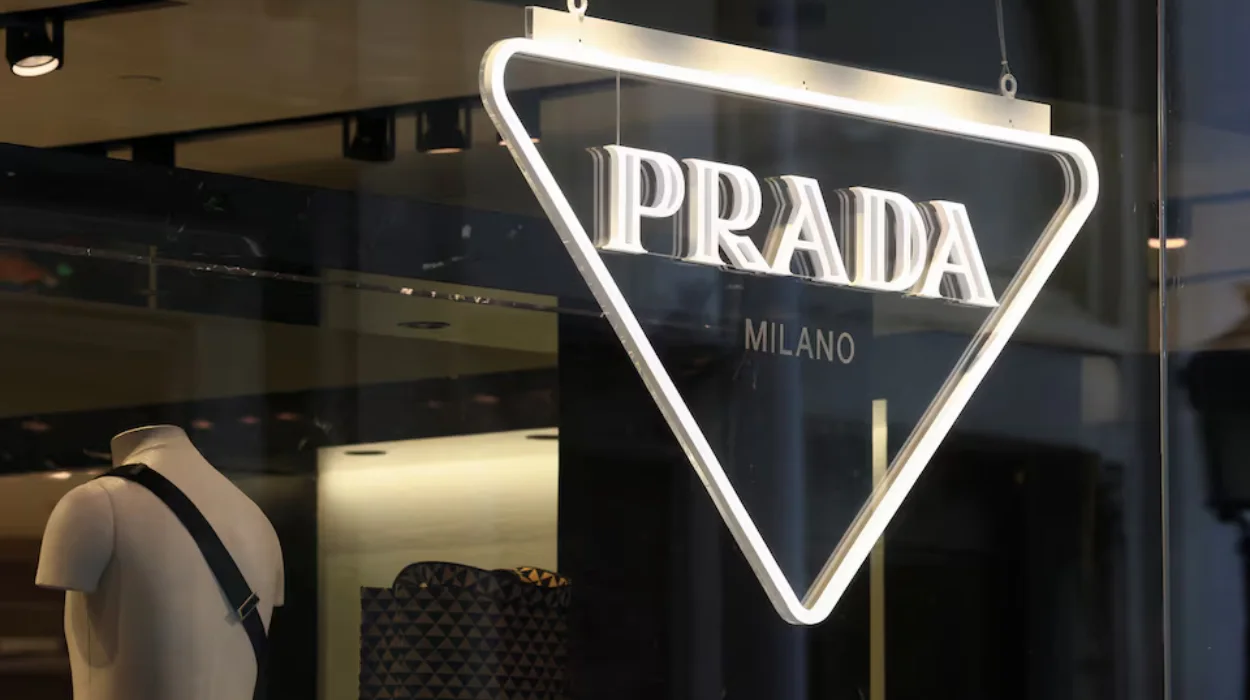Prada traced its roots to the year 1913 through the opening of the store Fratelli Prada, which deals in premium leather products by Mario Prada and his brother Martino in the famous shopping center Galleria Vittorio Emanuele II in Milan.
First, the shop initially dealt mostly with importing English animal products and steamer trunks and thus gave good quality leather bags, trunks, travel accessories, and other bizarre luxury items. Prada soon attracted high-profile customers to its excellent workmanship, which led to the company being declared an official vendor to the Italian Royal House in 1919. This enabled Prada to incorporate the house of Savoy coat of arms and the design of the knotted rope in its current trademark triangular logo, a symbol of the Italian aristocracy. Prada had its struggles in the 2000s, such as a botched offering in Hong Kong’s initial public offering (IPO) and short-term woes.
Nevertheless, this changed in the 2020s, when there was a revival, especially with the appointment of a new co-creative director, Raf Simons, in 2020 to work together with Miuccia Prada. However, assisted by some newly appointed executives such as the former Luxottica CEO Andrea Guerra, leadership transfer to the children of founders has begun to keep Prada developing and relevant.
Prada’s worth in the world
A multibillion-euro company with quite an impact on the global market, Prada had reported operational revenues of more than 4.2 billion euros and profits of nearly 776 million euros in 2022. In addition to building the representation of Prada in cultures and art frameworks, the cooperation with beginners and designers has developed the name outside the realm of garments.
The commitment by Prada to the environment by consuming environmentally friendly products and aiding in sustainability projects has been in line with the current business strategies. With respect to Prada, the company has made no permanent or political relationships with the country in the case of Israel, and its existence in the region is attributed to its worldwide retailing strategy. Prada has a rather neutral corporate policy on matters of geopolitics because it persists in international brand management rather than in political lobbying.
Prada’s relationship with Israel
As part of its global network of premium brand retail sites, Prada has retail stores in Israel, including ones in Tel Aviv. The products found in these stores include the accessory, apparel, footwear, and bag lines of Prada. It is not possible to present any evidence that the presence of Prada in Israel is a form of political support, but instead, it is the manifestation of the global business operations and the marketing strategy of this company. When it comes to geopolitical issues, Prada as a company remains neutral on basics of corporate level. Rather than taking blatant political stands, it publicly underlines sustainability, a responsible supplier network, and brand extension across the world. Thus, the relationship of Prada with Israel can be considered basic in the sense that Prada is a fashion boutique in an international market that neither forms any ownership as such, and any direct political influence related to Israel. Prada has over 600 directly controlled stores across over 70 different countries, including Israel, and targets rich and high-end clients.
The company also has international partners in the cosmetics and eyewear industries (through licensing of brands in the cosmetics market with Luxottica and L’Oréal in the cosmetics business), but such operations do not always indicate the political views of the company on Israel. It is worth noting that Prada Beauty has a joint venture with L’Oréal that has an estranged relationship with Israel, as per some activist sources, despite Prada not making a political stand in support of Israel.
How does Prad’s engagement with Israel affect it?
Prada follows a careful line of corporate neutrality on geopolitical issues; therefore, its activities in Israel, largely limited to stores in Israel as a part of the wider luxury clothing market, do not affect the global brand image of Prada. Rather than an active involvement in political affirmative action, the approach of the brand highlights strategies of sustainability, ethical supply chains, global economic activities, and cultural sensitivity. Artistic collaborations, geographical cultural positioning, and creativity are some of the ways Prada employs to enhance its global brand. Its sustainability, innovation, and artisanship in designs like the Re-Nylon project and ethical sourcing are more important factors to its reputation than its local shopping options.
The market entry of Prada in Israel is in line with its grand strategy of serving growing premium markets around the world, but at the same time, not forgetting about the origins of the brand and its major principles. This strategy increases the global outreach as well as the profitability of Prada without necessarily substantially impacting the reputation of the company in a politically controversial manner. Prada focuses on sustainability, moral principles, and luxury innovation to a great extent, which can easily obscure the knowledge of whether there is something wrong about its work in the Israeli market, leaving the luxury brand mostly aspirational and exclusive in the context of the international market, even though there is a chance some consumer groups might question geopolitically invested brands as a whole.
How costly are Prada’s products?
Prada is a high-end luxury brand, deliberately so. It keeps costs high in order to retain the impression of exclusivity, quality, and distinction. Scarcity is created by regulated distribution and small manufacturing runs, which raises demand and permits premium pricing. Like the company’s emphasis on great quality and prestige, other luxury products available at the Prada company, like shoes, clothes, and accessories, are set up at a high price range in the luxury market. Prioritizing traditional Italian workmanship while incorporating cutting-edge design and technology adds value beyond raw materials, which supports higher prices for distinctiveness and quality. Prada’s habit of rarely offering product discounts conveys exclusivity and excellence.
Customers’ fear of losing out is triggered by this scarcity, which encourages earlier and more expensive purchases. The prices are high due to high operating expenses incurred by Prada, such as the maintenance of the luxurious spaces in its boutiques, the employment of skilled laborers in production, and the rental of retail locations. Interest rates, tariffs charged on trade, inflation, and the fluctuation in the exchange rate all influence the pricing policies of Prada in foreign locations. As an example, an appreciation of the currency may cause an increase in the prices of commodities in certain regions. Supply chain costs, like logistics and shipping costs, and inflation, also affect the final prices. Prada focuses on clients with higher incomes because they can and are willing to afford more at high prices. Consumer preferences and demographic trends with regard to income change the demand and pricing strategy of some markets.
In a nutshell, Prada is a high-end Italian brand that is neither owned nor manufactured in Israel. The company’s global retail network includes outlets in Israel. Prada is not on boycott lists linked to Israel and has not stated political support for the country. Retail presence, which is not the same as political endorsement, is frequently the source of accusations of support.



